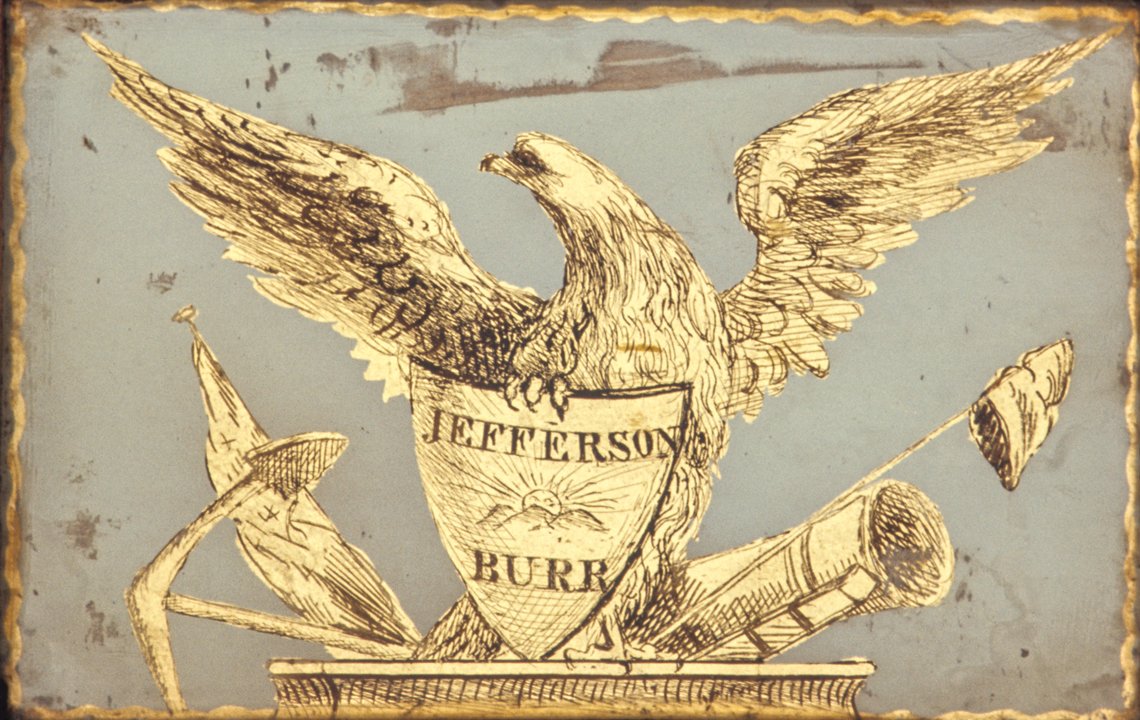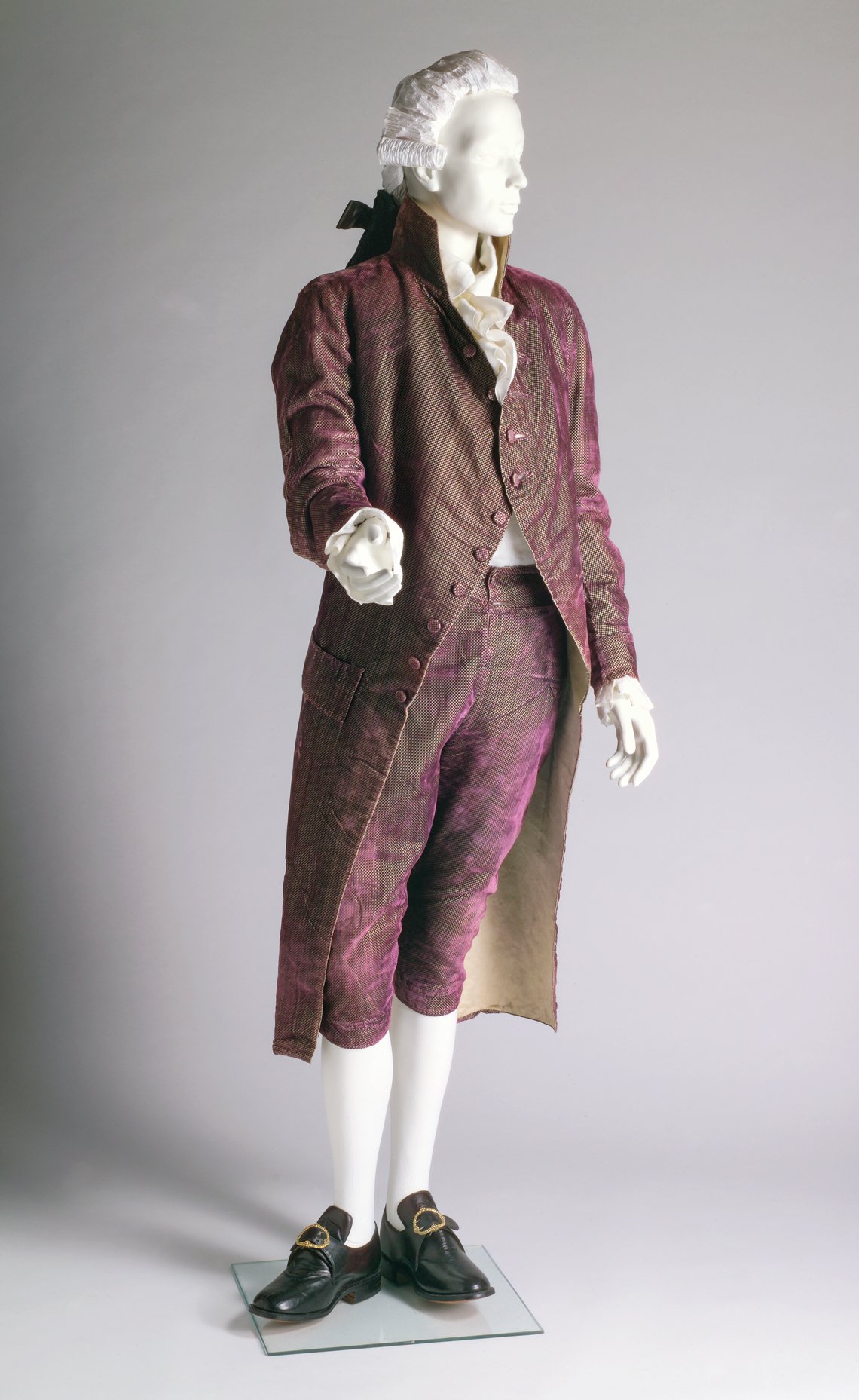Hamilton & Burr: Who Wrote Their Stories?
Winterthur Primer
 | |
Fig. 1: Card table, 1800, New York, NY. Mahogany, Pine, Walnut, Satinwood, Glass, Gold foil, Paint. Eglomise panel is painted with an eagle holding a shield inscribed “Jefferson / Burr.” Winterthur Museum; Gift of Henry Francis du Pont (1961.0144). |
On July 11, 1804, in Weehawken, New Jersey, Vice President Aaron Burr stood ten paces from former Secretary of the Treasury Alexander Hamilton. Each grasped one of a pair of Wogdon & Barton pistols. In just a few moments a decades-long rivalry ended and two legacies were solidified; Alexander Hamilton, Founding Father, and Aaron Burr, the one who killed him. But how did they find themselves settling their differences in a duel? The Winterthur Museum exhibition, Hamilton & Burr: Who Wrote their Stories considers how a cast of characters shaped their relationship in life and the perspectives from which their legacies were written.
Burr’s reputation began to crumble as a result of an unlikely alliance. The election of 1800 represented a breaking point in the early Republic. Events during the Adams’ administration greatly enhanced opposition between the Democratic-Republicans and the Federalists. To secure both the Presidency and Vice-Presidency each party ran two candidates. Though the Democratic-Republicans won the majority of electoral votes their candidates, Thomas Jefferson and Aaron Burr, tied. Burr was expected to cede the election to the party leader, Jefferson, but instead pursued the Presidency.
 | |
Fig. 1a: Detail of the églomisé panel on the table illustrated in figure 1. |
Alexander Hamilton, co-leader of the Federalist Party, detested Jefferson, but thought he could be swayed to maintain Hamilton’s financial structure. Meanwhile, recent personal and professional maneuvers left mistrust between Burr and Hamilton, where friendship had once been. Hamilton publicly claimed “Jefferson had pretentions to character.” Burr did not; his words helped sway the deadlocked House of Representatives. Jefferson was declared the President with Burr as Vice President. For Democratic-Republicans the election was a great victory. Commemorative objects adorned households during the campaign and after. A pair of mahogany card tables with églomisé panels reading “Jefferson Burr” were made as a particularly grandiose celebratory gesture (Figs. 1, 1a).1 However, for Burr it represented the dissolution of his alliance with Jefferson and a serious evolution in his rivalry with Hamilton. After 1800 Burr never won another election.
 | |
Objects like this velvet coat inspired the costumes of Lin-Manuel Miranda’s Hamilton: An American Musical. Velvet coat with silk wefts, 1780-1800. Winterthur Museum; Gift of Ann Wyeth McCoy in memory of John W. McCoy (2004.0062.001). |
In 1804 during Burr’s campaign for New York State governor, a private letter between Hamilton’s friends was published in newspapers. It stated Hamilton claimed Burr was “a dangerous man…who ought not to be trusted.”2 Burr rarely retaliated, but, blaming Hamilton for decades of personal and political misfortunate, Burr challenged him to a duel. Duels were seldom fatal and decorum dictated they be kept private. The outcome of this one, however, outraged the nation. Hamilton’s allies shaped Burr as the murderer of a fallen hero, a reputation that would define his legacy for more than two centuries.
The history surrounding Alexander Hamilton and Aaron Burr often focuses on the duel as an embodiment of contentious bi-partisan debate. In part because Hamilton’s wife, Elizabeth Schuyler Hamilton, worked tirelessly for fifty years to affirm her husband’s legacy as a great writer and political mind. Burr’s daughter, Theodosia Burr Alston, strove to restore her father’s reputation, but she died young, and much of Burr’s legacy remained fixed after her death.
Today, playwright Lin-Manuel Miranda challenges our narrative of this duo again. Hamilton: An American Musical rewrote our expectations of the two by recontextualizing their relationship and highlighting issues of race, immigration, and memory into the discussion. Miranda’s stage production is an exploration of Hamilton’s complex life and legacy that directs us to ask questions about who we remember and why. He, along with modern scholars and novelists, offer us an opportunity to write a new chapter to their stories.
 |
The objects shown here are among the many Hamilton- and Burr-related pieces featured in Hamilton & Burr: Who Wrote their Stories?, on view at the Winterthur Museum, Garden and Library through January 5, 2020. For information, call 800.448.3883 or visit www.winterthur.org.
1. Today, one table is at Winterthur, the other is held in a private collection.
2. Charles D. Cooper, to Phillip Schuyler, April 23, 1804. Published in The Albany Register, April 24, 1804.
When this article was written, Rebecca Duffy was the Sewell C. Biggs Curatorial Fellow at Winterthur Museum, Library, and Garden in Delaware, where she curated Hamilton & Burr: Who Wrote their Stories? She is currently the education coordinator for the Read House & Gardens in New Castle, Delaware.
This article was originally published in the Autumn 2019 issue of Antiques & Fine Art magazine, a fully digitized version of which is available at www.afamag.com. AFA is affiliated with Incollect.com.



























